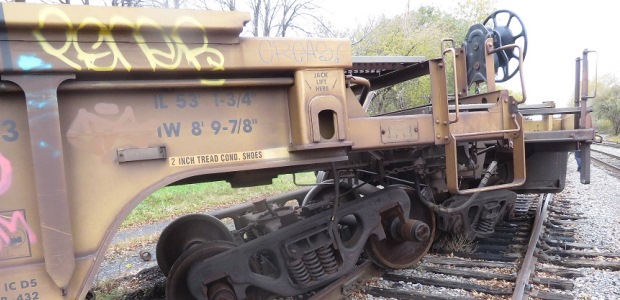
Derailed Cars Moved Because of Human Intervention, TSB Finds
The agency reported that in Canada between 2006 and 2015, 397 occurrences involving uncontrolled movements of rolling stock or equipment were reported to the TSB, and about 8 percent of them were caused by human intervention.
The Transportation Safety Board of Canada (TSB) has determined that uncontrolled movement and derailment of a parked cut of rail cars in October 2015 on a non-main track in Montreal occurred because human intervention likely put the rail cars in motion.
There were 26 cars secured on the storage track on Oct. 29, 2015, near the Canadian Pacific Railway Hochelaga Yard, when they began to roll. They rolled uncontrolled about 120 feet before striking a hinged derail. The derail, a mechanical device designed to stop uncontrolled rolling stock and equipment by derailing it, derailed only the first car before being torn from the track. The remaining cars continued to descend the grade, reaching a second derail located about 400 feet further, which caused the following four cars to derail, as the first derailed car went over an embankment and struck a residential property.
Occupants of that house and six nearby homes were evacuated, and that house and the cars and the track were damaged, but no hazardous materials were involved and there were no injuries.
The rail cars had not been moved since they were stored in May 2015. "Since there had been no reports of extreme weather in the region, and that handbrake effectiveness does not generally degrade over time, the investigation determined that a human intervention had likely reduced the braking force, allowing gravity to set the cars in motion. Despite heightened surveillance in the area, railway personnel had been encountering trespassers regularly along the tracks where the cars were stored. However, the railway did not identify this condition as a hazard when choosing to store cars at this location, and no special inspections of the cars were being conducted," according to the board, which released its report Feb. 22.
The agency reported that in Canada between 2006 and 2015, 397 occurrences involving uncontrolled movements of rolling stock or equipment were reported to the TSB, and about 8 percent of them were caused by human intervention. "Because it is relatively simple to release the handbrake mechanism on a rail car, stored rail cars are vulnerable to tampering by unauthorized persons. If measures to prevent tampering with hand brakes on cars stored in areas frequented by trespassers are not taken, there is an increased risk that rolling stock will move uncontrolled." The board has previously issued a recommendation to require fencing along railway right-of-way in areas where there are frequent pedestrian incursions.
After the derailment occurred, Canadian Pacific took several additional measures to eliminate trespassing at the location.